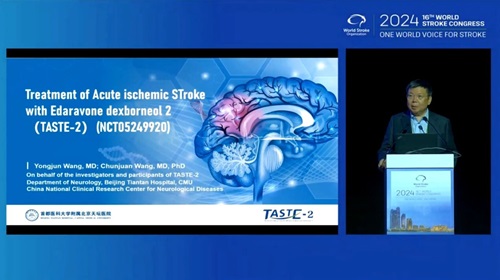
Simcere Pharmaceutical Group has announced that a new study with major clinical findings regarding Sanbexin—an edaravone-dexborneol concentrated solution for injection—was recently presented at the 16th World Stroke Congress (WSC; 23–26 October, Abu Dhabi, United Arab Emirates). According to the data, the administration of Sanbexin prior to undergoing an endovascular thrombectomy procedure significantly improved neurofunctional recovery and reduced stroke-related disability in patients with acute ischaemic stroke.
Data from TASTE-2, the trial in question, were delivered in a late-breaking oral presentation at WSC 2024 by Yongjun Wang (Beijing Tiantan Hospital, Beijing, China).
TASTE-2—a multicentre, double-blind, randomised, placebo-controlled clinical study—enrolled a total of 1,362 acute ischaemic stroke patients with an anterior-circulation large vessel occlusion (LVO) from March 2022 to May 2023. Patients were randomly allocated at a 1:1 ratio to receive edaravone-dexborneol (edaravone, 30mg; (+)-dexborneol, 7.5mg) or placebo prior to thrombectomy, with treatment continuing twice per day over a consecutive period of 10–14 days.
As per the trial’s primary efficacy outcome, 379 patients (55%) in the edaravone-dexborneol group and 333 in the placebo group (49.6%) achieved a modified Rankin scale (mRS) score of 0–2 at day 90 (odds ratio [OR] 1.24, 95% confidence interval [CI], 1–1.54; risk ratio [RR] 1.11, 95% CI 1–1.23). In addition, all safety outcomes were similar between the two groups.
This suggests that edaravone-dexborneol could improve the rate of 90-day favourable functional outcomes in acute ischaemic stroke patients within 24 hours of symptom onset who have undergone endovascular thrombectomy, according to a recent press release from Simcere.
The company also states that Sanbexin as a multi-targeted brain cell protection agent, describing it as “the only approved innovative drug in the field of stroke treatment worldwide since 2015”. Composed of edaravone and dexborneol—two active ingredients with synergistic antioxidant and anti-inflammatory effects—the drug can significantly reduce brain cell injury or impairment caused by acute ischaemic stroke, the release adds.
“According to the recommendations of the Stroke Academic Roundtable Meeting (STAIR), brain cytoprotectants can reduce ischaemic brain injury, especially when combined with thrombectomy. The scientific community has also been working on brain cytoprotective agents for stroke treatment for decades,” Simcere’s press release notes. “However, due to the complexity of stroke pathophysiology, single-target drugs have been found to have limited efficacy and to be difficult to develop clinically.”
Nevertheless, the release continues, the clinical study of multi-target brain cytoprotectants “continues to progress”. Simcere claims that the TASTE study, led by Wang’s team at Beijing Tiantan Hospital—and also the TASTE-SL study led by Dongsheng Fan (Peking University Third Hospital, Beijing, China) and published in JAMA Neurology earlier this year—have confirmed the efficacy of edaravone-dexborneol injection and sublingual tablets in acute ischaemic stroke patients who do not receive reperfusion treatment.
“The latest results of the TASTE-2 study provide key clinical medical evidence for Sanbexin as a multi-target brain cell protection strategy combined with reperfusion in the treatment of acute ischaemic stroke,” the company’s release concludes. “Sanbexin is expected to be used as a concomitant drug for endovascular treatment, such as thrombectomy—particularly before reperfusion—to further improve the effect of stroke treatment and reduce stroke disability.”










